Part One: Melody
Focuses on single note soloing. Learn how to effortlessly solo through complex chord changes.
Free Jazz Guitar Lessons with Chris Standring
The major 6 chord, sometimes called an 'add 6th' chord is simply a
major triad with a 6th degree of the chord added to that triad. For
example, in C major, a C triad as we know is C, E and G. 'C6' would
therefore be C, E, G and A. (It's actually the same notes as A minor7
but with the notes inverted).
The 6th chord is quite a happy sound and was used extensively in the
sentimental jazz period from 1920 through 1950. Cole Porter, George
Gershwin, Jerome Kern and many others of that romantic time used these
chords to brighten up their music. Let's have a look at some basic fingerings.
First let's look at our parent chord C major, followed by a C6 chord.
Look at where the degrees of the chord lie so you can understand how
the chord is derived.
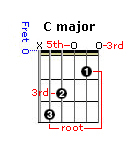
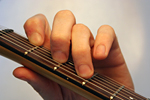
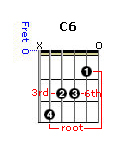
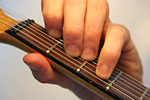
Notice that in order to play the C6 chord you need
to change your fingering a little. Replace your 3rd finger on the note
C with your 4th finger on the note C (5th string) so you can then add
the 6th degree on your third string. (In this situation we are are replacing
the 5th degree with the 6th degree, but only for convenience). This
shape, although in open position, can also be used as a movable chord
where your root note is on the 5th string. Make sure you don't hit any
open strings if you want to use this shape up and down the fretboard
in different keys.
Let's now look at two more movable 6th chord shapes. First with a 6th
string root. Don't confuse this shape with Fmajor7. It looks a little
similar but Fmajor7 would have it's root on the 5th string. In this
C6 chord the root is clearly C and it sits on the 6th string.
C6 (6th string root)

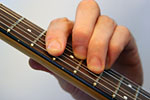
Now let's try it with a 5th string root. This chord is a little tricky and you might want to substitute your 3rd finger barre with your 4th finger. It may or may not be a little easier for you. Try both, either is perfectly acceptable.
C6 (5th string root)

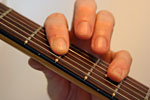
Move these chord shapes around up and down the fretboard chromatically and get used to feeling the shapes in different keys.
Free online jazz guitar lessons for beginners, intermediates and advanced.
Online jazz guitar instruction from recording artist Chris Standring
Join The Inside Track membership and get access to all Chris Standring's guitar instructional programs, all in one place.
It has been many years since the first edition of Play What You Hear (originally released in 2000). Now volume two is here with new ideas and concepts, complete with audio, video, traditional notation and TAB throughout. High resolution pdf available for printing the entire program. For intermediate and advanced players.
Focuses on single note soloing. Learn how to effortlessly solo through complex chord changes.
Focuses on chord melody. Learn new harmonic devices and understand chords in a whole new way.
Study Chris Standring's six recorded solos, transcribed with audio and high def video.
Copyright © PlayJazzGuitar.com - All Rights Reserved.